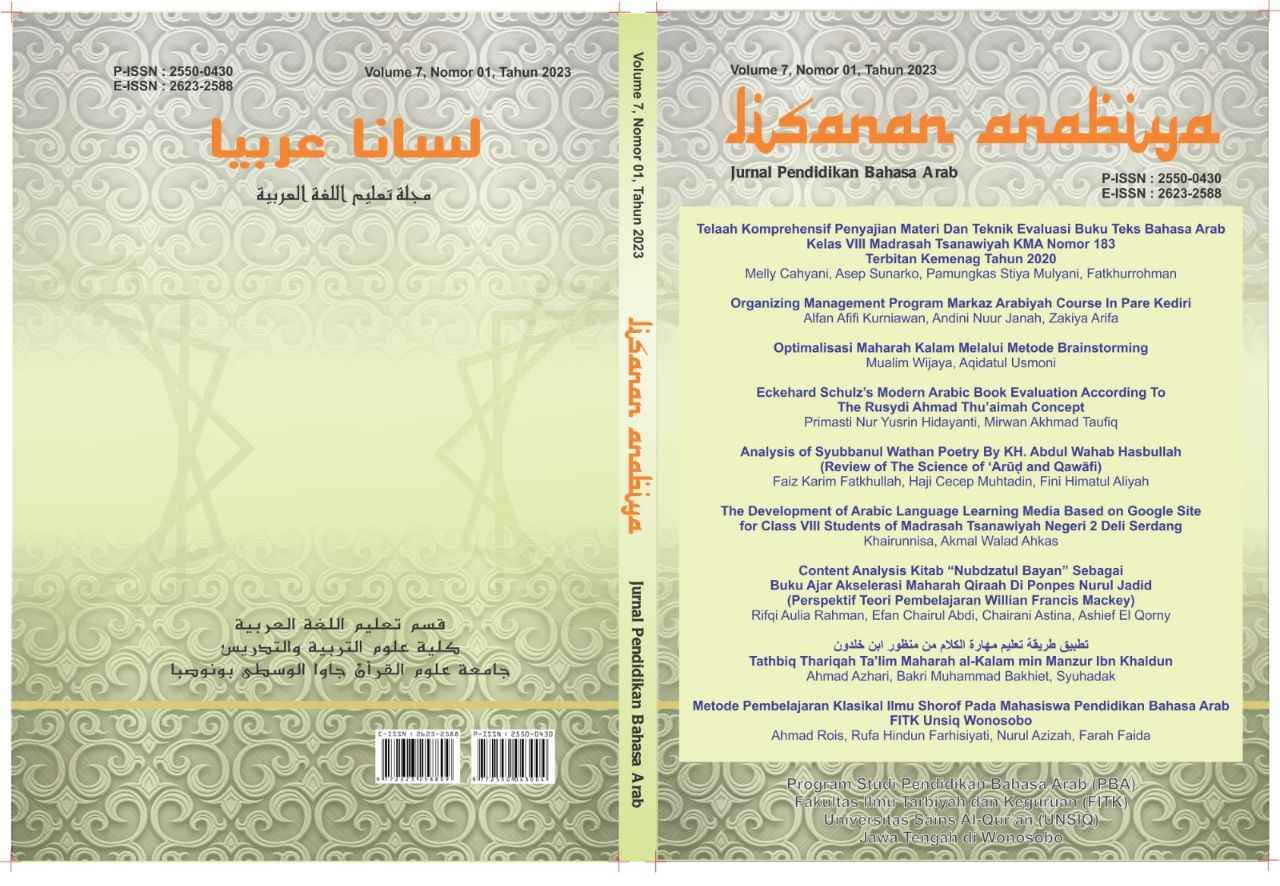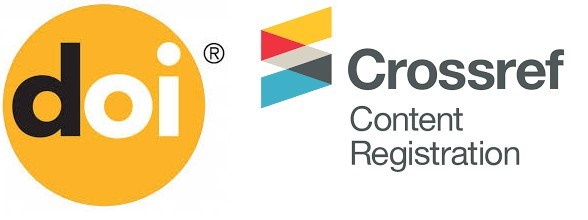Eckehard Schulz's Modern Arabic Book Evaluation According To The Rusydi Ahmad Thu'aimah Concept
DOI:
https://doi.org/10.32699/liar.v7i1.4362Keywords:
Textbooks Analysis, Learning Arabic, Rusydi Ahmad Thu'aimahAbstract
Textbooks are the main component used in assisting educators in delivering learning materials. The selection of the right textbook can affect the achievement of existing learning objectives. The Modern Arabic Book by Eckehard Schulz is a source of learning media in the form of printed books used by students at Sunan Ampel University Surabaya in learning and recognizing Arabic. The purpose of this research is to analyze and assess the suitability of the teaching materials presented in Arabic books with the theoretical principles of textbook development that Rusydi Ahmad Thu'aimah has established. In this study, the researcher used a qualitative descriptive type, and data collection was in document analysis. The study results stated that Eckehard Schulz's Modern Arabic book followed Rusydi Ahmad Thu'aimah's theory in the principle of textbook feasibility. Modern Arabic books contain five main principles in teaching materials, namely valid, meaningful, inclination and attention, worthy of study and global. The presentation of complete teaching materials includes four language skills: speaking, listening, reading and writing. The material is arranged sequentially to make it easier for students. However, some things could be improved in the book, namely, in grouping the main themes in Arabic textbooks.
References
Bahy, M. B. A., & Taufiq, M. A. (2022). Analisis Buku Ajar Bahasa Arab Tingkat Madrasah Ibtidaiyah Perspektif Amani dan Awatif. Taqdir, 7(2), 245–256. https://doi.org/10.19109/taqdir.v7i2.10175
Degeng, & Sudana, I. nyoman. (2013). Ilmu Pembelajaran Klasifikasi Variable untuk Pengembangan Teori dan Penelitian. Aras Media.
Febrianto, R., & Puspitaningsih, F. (2020). Pengembangan Buku Ajar Evaluasi Pembelajaran. Education Journal : Journal Educational Research and Development, 4(1), 1–18. https://doi.org/10.31537/ej.v4i1.297
Fitriani, N., & Saefulloh, H. (2018). Analisis Bahan Ajar “Buku Siswa Bahasa Arab” Untuk Kelas 6 Madrasah Ibtidaiyah (Pendekatan Saintifik 2013). EL-IBTIKAR: Jurnal Pendidikan Bahasa Arab, 7(2), 115. https://doi.org/10.24235/ibtikar.v7i2.3336
Guntur, H., & Tarigan, D. (1986). Telaah Buku Teks Bahasa Indonesia. Angkasa.
Hidayanti, P. N. Y., Taufiq, M. A., & Maturedy, F. (2021). Analisis Buku Bahasa Arab Tingkat MPDM Muhammadiyah. Al-Itijah: Jurnal Keilmuan Dan Kependidikan Bahasa Arab, 13(2), 153–169. https://doi.org/https://doi.org/10.32678/al-ittijah.v13i2.4614
Khairunnisa, F. (2019). Evaluasi Komponen Kelayakan Isi Buku Ajar Bahasa Indonesia: Kesesuaian Materi dengan Kurikulum. Jurnal Penelitian Pendidikan Bahasa Dan Sastra, 4(1), 408–416. https://doi.org/https://doi.org/10.32696/ojs.v4i1.220
Machmudah, U. (2018). Model Bahan Ajar Bahasa Arab Sekolah Dasar Islam di Kota Malang. An Nabighoh, 20(02), 202–221. https://doi.org/10.32332/an-nabighoh.v20i02.1284
Mastutik, N. A. P., & Taufiq, M. A. (2021). Analisis Pemelihan Kosakata dalam Buku Ajar Perspektif Rusydi Ahmad Thu ’ aimah. Al-Ittijah: Jurnal Keilmuan Dan Kependidikan Bahasa Arab, 13(2), 119–132. https://doi.org/https://doi.org/10.32678/al-ittijah.v13i2.5042
Melsaac, M. S., & Gunawardena. (1996). Handbook of Research for Educational Communications and Technology. AECT.
Nisak, U. C., & Taufiq, M. A. (2021). BUKU TERJEMAH KITAB TA’LIMU AL-MUTA’LIM; ANALISIS TEKS TERJEMAHAN ARAB-INDONESIA. لسـانـنـا (LISANUNA): Jurnal Ilmu Bahasa Arab Dan Pembelajarannya, 10(2), 365. https://doi.org/10.22373/ls.v10i2.8836
Nugroho, M. A. (2016). Buku Ajar Bahasa Arab Madrasah Tsanawiyah. Arabia, 8(2), 215–238.
Riham, L. W. (2020). Evaluasi Buku Ajar Bahasa Arab Kelas X Madrasah Aliyah: Pendekatan Saintifik Kurikulum 2013. Al-Ma’rifah, 17(1), 41–47. https://doi.org/10.21009/almakrifah.17.01.04
Rusydi, A. T. (1985). دليل عمل في إعداد المواد التعليمية لبرامج تعليم العربية (1st ed.). Universitas Ummul Quro’.
Sabilar, R. (2018). Analisis Buku Ajar Bahasa Arab Siswa Kelas VIII MTs/SMP ISlam Dalam Prespektf Gender. JALIE, 02(September), 2018.
Schulz, E., & Maisel, S. (2013). Modern Standard Arabic-. Edition Hamouda.
Sudrajat, A. (2008). Pengertian pendekatan, strategi, metode, teknik, taktik, dan model pembelajaran. Tersedia: Http://Akhmadsudrajat. Wordpress. Com/2008/09/12/Pengertian-Pendekatan-Strategi-Metode-Tekniktaktik-Dan-Model-Pembelajaran/.[20 Oktober 2008], 1.
Sugiyono. (2015). Metode Penelitian Pendidikan (Pendekatan Kuantitatif, Kualitatif dan R&D). Alfabeta.
Supriadi, S. (2017). Pemanfaatan Sumber Belajar Dalam Proses Pembelajaran. Lantanida Journal, 3(2), 127. https://doi.org/10.22373/lj.v3i2.1654
Susanti, R. D. (2013). Studi Analisis Materi Ajar “Buku Teks Pelajaran“ Pada Mata Pelajaran Bahasa Arab di Kelas Tinggi Madrasah Ibtidiyah. Arabia, 5(2), 199–223.
Syaifullah, M., & Izzah, N. (2019). Kajian Teoritis Pengembangan Bahan Ajar Bahasa Arab. Arabiyatuna : Jurnal Bahasa Arab, 3(1), 127. https://doi.org/10.29240/jba.v3i1.764
Taufiq, M. A., & Nashrullah, M. (2021). Analisis Buku Bahasa Arab Pegangan Guru dan Siswa Kelas XI Kurikulum 2013 Cetakan Kementerian Agama. TSAQOFIYA: Jurnal Pendidikan Bahasa Dan Sastra Arab, 3(1), 16–25. https://doi.org/10.21154/tsaqofiya.v3i1.51
Thalha, A., & Budur, A. (2019). Instrumen Pengumpulan Data. Sekolah Tinggi Agama Islam Negeri Sorong, 1–20.
Yakin, A. (2019). Evaluasi Diktat Bahasa Arab KElas X SMA Negeri 2 Sampang. Prosiding Konferensi Nasional Bahasa Arab V, 1, 114–123. https://doi.org/https://doi.org/10.32699/liar.v1i02.204
Yasmadi. (2015). Evaluasi Buku Ajar Bahasa Arab: Telaah Terhadap Instrumen Penilaian Abdurrahman Ibrahim Fauzan. Jurnal At-Tarbiyah, VI, 1–15.
Zaenuri, M. (2019). Analisis Buku Ajar Belajar Membaca Kitab Kuning Metode Ibtida’i Karya Mujahidin Rohman. Arabia, 11(1), 191. https://doi.org/10.21043/arabia.v11i1.5255
Downloads
Published
Issue
Section
License
Authors who publish with this journal agree to the following terms:
a. Authors retain copyright and grant the journal right of first publication with the work simultaneously licensed under a Creative Commons Attribution-ShareAlike 4.0 International License. that allows others to share the work with an acknowledgement of the work's authorship and initial publication in this journal.
b. Authors are able to enter into separate, additional contractual arrangements for the non-exclusive distribution of the journal's published version of the work (e.g., post it to an institutional repository or publish it in a book), with an acknowledgement of its initial publication in this journal.
c. Authors are permitted and encouraged to post their work online (e.g., in institutional repositories or on their website) prior to and during the submission process, as it can lead to productive exchanges, as well as earlier and greater citation of published work (See The Effect of Open Access).












